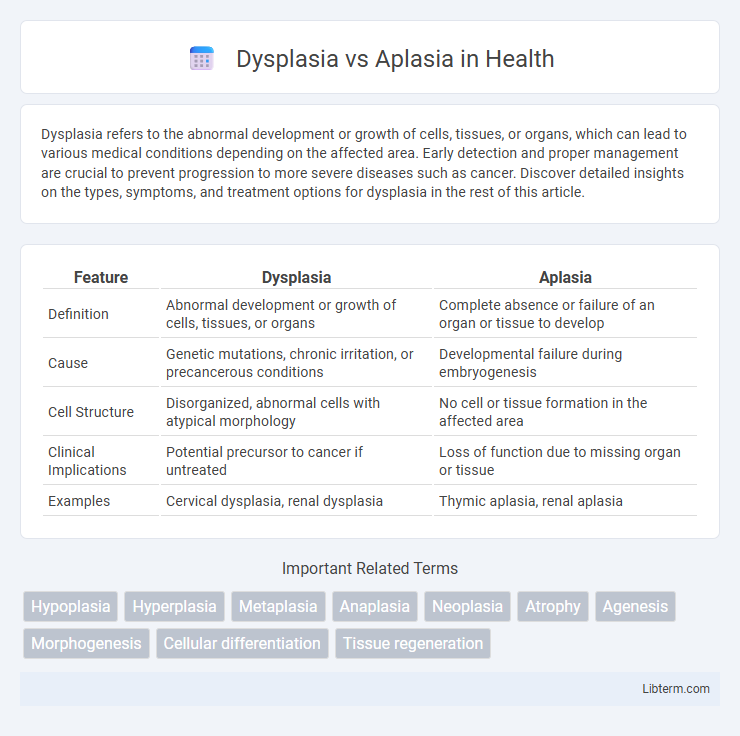Dysplasia refers to the abnormal development or growth of cells, tissues, or organs, which can lead to various medical conditions depending on the affected area. Early detection and proper management are crucial to prevent progression to more severe diseases such as cancer. Discover detailed insights on the types, symptoms, and treatment options for dysplasia in the rest of this article.
Table of Comparison
| Feature | Dysplasia | Aplasia |
|---|---|---|
| Definition | Abnormal development or growth of cells, tissues, or organs | Complete absence or failure of an organ or tissue to develop |
| Cause | Genetic mutations, chronic irritation, or precancerous conditions | Developmental failure during embryogenesis |
| Cell Structure | Disorganized, abnormal cells with atypical morphology | No cell or tissue formation in the affected area |
| Clinical Implications | Potential precursor to cancer if untreated | Loss of function due to missing organ or tissue |
| Examples | Cervical dysplasia, renal dysplasia | Thymic aplasia, renal aplasia |
Understanding Dysplasia and Aplasia: An Overview
Dysplasia refers to the abnormal development or growth of cells, tissues, or organs, often characterized by irregular cell size, shape, and organization, which can be precancerous. Aplasia is the complete failure of an organ or tissue to develop, resulting in the absence of the affected structure, commonly seen in conditions like aplastic anemia. Recognizing the differences between dysplasia's cellular disorganization and aplasia's developmental absence is crucial for accurate diagnosis and treatment planning in medical practice.
Defining Dysplasia: Causes and Characteristics
Dysplasia refers to the abnormal development or growth of cells, tissues, or organs, often indicating an early stage of cellular disorganization and atypia that can precede malignancy. It is caused by factors such as chronic inflammation, genetic mutations, and exposure to carcinogens, which disrupt normal cell differentiation and proliferation. Characteristic features of dysplasia include irregular cell size and shape, loss of tissue architecture, and increased mitotic activity, distinguishing it from aplasia, where there is a complete absence of tissue formation.
What is Aplasia? Key Features and Origins
Aplasia is a congenital condition characterized by the complete absence of an organ or tissue due to the failure of primordial cells to develop during embryogenesis. Key features of aplasia include the lack of formation of specific structures such as bone marrow, kidney, or limbs, leading to significant functional impairments. The origins of aplasia are often linked to genetic mutations, environmental factors, or disruptions in cellular differentiation pathways during early fetal development.
Developmental Differences: Dysplasia vs Aplasia
Dysplasia involves abnormal development or growth of tissues or organs due to genetic or environmental factors, resulting in disorganized cell architecture. Aplasia refers to the complete absence of an organ or tissue caused by failure of the primordial cells to develop during embryogenesis. The key developmental difference lies in dysplasia's presence of malformed but existing tissues versus aplasia's total lack of organ formation.
Clinical Manifestations of Dysplasia
Dysplasia presents with abnormal cellular development and organization, often causing tissue enlargement, irregular morphology, and functional impairment. Clinically, patients may exhibit visible lesions, ulcerations, or thickened mucosa, with symptoms varying according to the affected organ system. Early detection through biopsy is critical since dysplasia can progress to malignancy if untreated.
Clinical Presentation of Aplasia
Aplasia clinically presents with a complete absence or severe underdevelopment of a tissue or organ, often resulting in significant functional deficits depending on the affected site. Common manifestations include bone marrow aplasia leading to pancytopenia, characterized by anemia, infections, and bleeding tendencies due to lack of hematopoietic cells. Early diagnosis through clinical evaluation and laboratory tests is crucial for effective management and potential interventions like bone marrow transplantation.
Diagnosis: Distinguishing Dysplasia from Aplasia
Dysplasia is characterized by abnormal tissue development with disorganized cell growth, while aplasia denotes the complete absence of an organ or tissue due to failed development. Diagnosis relies heavily on histopathological examination, where dysplasia shows cellular atypia and architectural distortion, whereas aplasia reveals no cellular or tissue presence. Imaging techniques such as MRI or ultrasound can aid in identifying aplasia by confirming missing anatomical structures, contrasting with dysplasia where altered but present tissue is observed.
Common Conditions Associated with Dysplasia
Dysplasia is commonly associated with conditions such as cervical intraepithelial neoplasia, Barrett's esophagus, and osteodysplasia, reflecting abnormal cellular growth and tissue architecture that often precedes malignancy. In contrast, aplasia involves the complete absence of an organ or tissue due to developmental failure, seen in conditions like renal aplasia or bone marrow aplasia. Understanding dysplasia's role in precancerous states is crucial for early diagnosis and prevention of cancer progression.
Disorders Commonly Linked to Aplasia
Aplasia, characterized by the complete absence of an organ or tissue, is commonly linked to disorders such as aplastic anemia, where bone marrow fails to produce sufficient blood cells, and thalidomide-induced phocomelia, resulting in limb absence. Dysplasia involves abnormal tissue development rather than total absence, often associated with conditions like congenital dysplasia of the hip and bronchopulmonary dysplasia. Understanding aplasia's impact on hematopoietic and skeletal systems is crucial for accurate diagnosis and treatment planning in affected patients.
Treatment Approaches: Managing Dysplasia and Aplasia
Treatment approaches for dysplasia often involve monitoring with regular biopsies and surgical excision to prevent progression to malignancy, with specific strategies tailored to the severity and location of abnormal cell growth. Aplasia treatment focuses on supportive therapies such as hematopoietic stem cell transplantation for aplastic anemia or organ-specific interventions to compensate for the absence of tissue development. Both conditions require multidisciplinary management, including hematologists, surgeons, and pathologists, to optimize patient outcomes through targeted medical and surgical therapies.
Dysplasia Infographic

 libterm.com
libterm.com